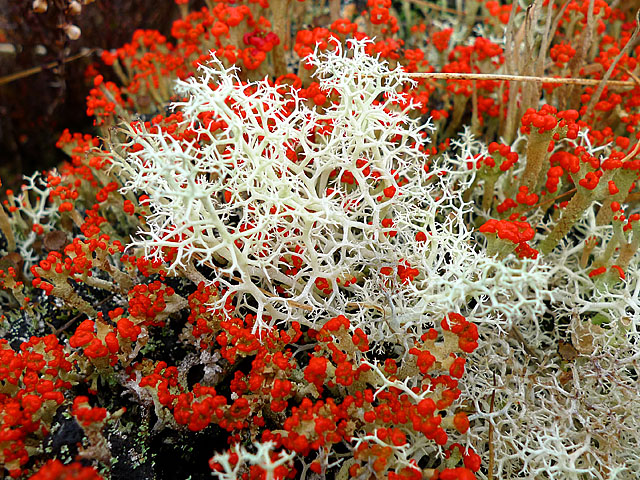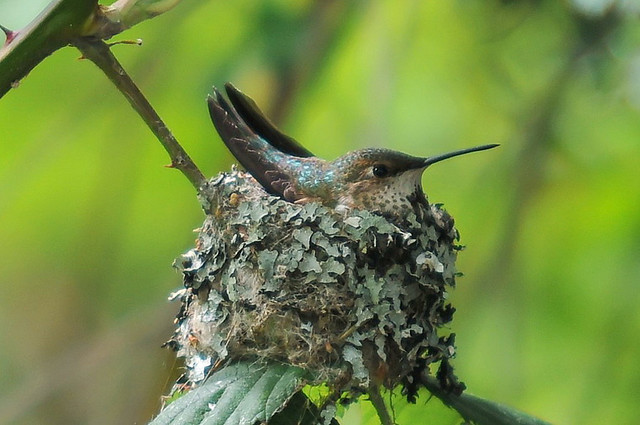
Summary
Lichens are often mistaken as mosses or fungi but are their own group with thousands of species. Lichen are actually a fungus living closely with another organism (either algae or cyanobacteria). Lichens are also used as shelter or food by many animals including humans.
The Mutualistic Relationship
A lichen is made up of both a fungus and either algae or cyanobacteria (microscopic single celled organisms that can photosynthesize). The fungus acts like a trellis for either photosynthesizing teammate to grow on, while the algae or cyanobacteria turn sunlight into a shared food source.
Spotting a Lichen
Lichen grow on many surfaces; tree bark, rocks, and soil are common places. They come in a rainbow of colors and an array of shapes including fruticose, foliose, and crustose. A fruticose lichen grows up with thin bushy branches, a foliose lichen grows out with leaf-like structures, while a crustose lichen covers a surface like a crust.





Ecology
Various animals, from microscopic mites to humans, use lichens as shelter or food. Salamanders, frogs, and lizards use lichen for camouflage while hummingbirds are known to use lichen for insulation when building their nests. In the cold tundra of the north herbivores rely on lichen to make it through the winter when plants are scarce. Small mammals in our area, including flying squirrels and voles, also use lichens as food sources. Humans have even made bread out of lichen.
A study in the Adirondack Mountains, led by Heather Root, found that lichen can house a host of other organisms: the mites. Mites are small animals related to ticks and spiders that have been found living in lichen in the canopies of trees. The shape, texture, and even color determines how many mites a lichen can support. The mites are so small that they are affected by the miniscule changes in climate between living under a leaf of a foliose lichen verse in the cracks of a crustose lichen or living on a light green lichen versus a black one. The levels of moisture can differ depending on the lichen's shape, and the heat absorbed from sunlight can differ depending on the color. Root found that a foliose lichen can support a mite population seven times larger than bare tree bark.
Interesting Facts
- Crustose lichen growth can be used to date natural phenomena like glacial retreats, landslides, and earthquakes
- Lichen have been used by people as medicine, dye, and food
- Lichen absorb radioactive fallout more readily than plants

References
Bungartz. (n.d.). An overview on the biology of lichens. Arizona State University College of Liberal Arts and Sciences. http://nhc.asu.edu/lherbarium/lichen_info/
T. Root, G. G. McGee, and R. A. Norton. 2007. Arboreal mite communities on epiphytic lichens of the Adirondack Mountains of New York. Northeastern Naturalist. http://www.jstor.org/stable/4499930
Sharnoff and R. Rosentreter. February 1998. Lichen use by wildlife in North America. Lichens of North America. http://www.lichen.com/fauna.html
Goward, A. MacKinnon, J. Hollinger, et al. March 2017. Ways of enlichenment. http://www.waysofenlichenment.net
Image Credit
Cladonia Lichens: "Cladonia lichens" by Dr. Richard Murray, licensed under CC BY-SA 2.0
Lichen Species: "Lichen forest" by Jim McCulloch, licensed under CC BY 2.0
Fruticose Lichen: "Dixie Reindeer Lichen" by Jason Hollinger, licensed under CC BY 2.0
Foliose Lichen: "Lobaria pulmonaria" by Bernd Haynold, licensed under GFDL and CC BY-SA 1.0, 2.0, 2.5, 3.0. Image cropped. Cropped image licensed under CC BY-SA 4.0.
Crustose Lichens: "Lichens" by Jared Tarbell, licensed under CC BY 2.0
Hummingbird Nesting with Lichen: "Nesting Female Rufous Hummingbird" by Brendan Lally, licensed under CC BY 2.0
Lichen Loaves: "Loaf of cooked wila lichen" by Millifolium, licensed under GFDL and CC BY-SA 3.0